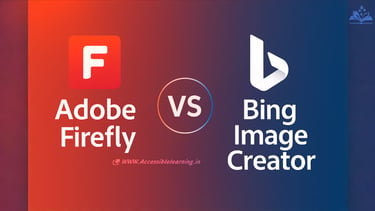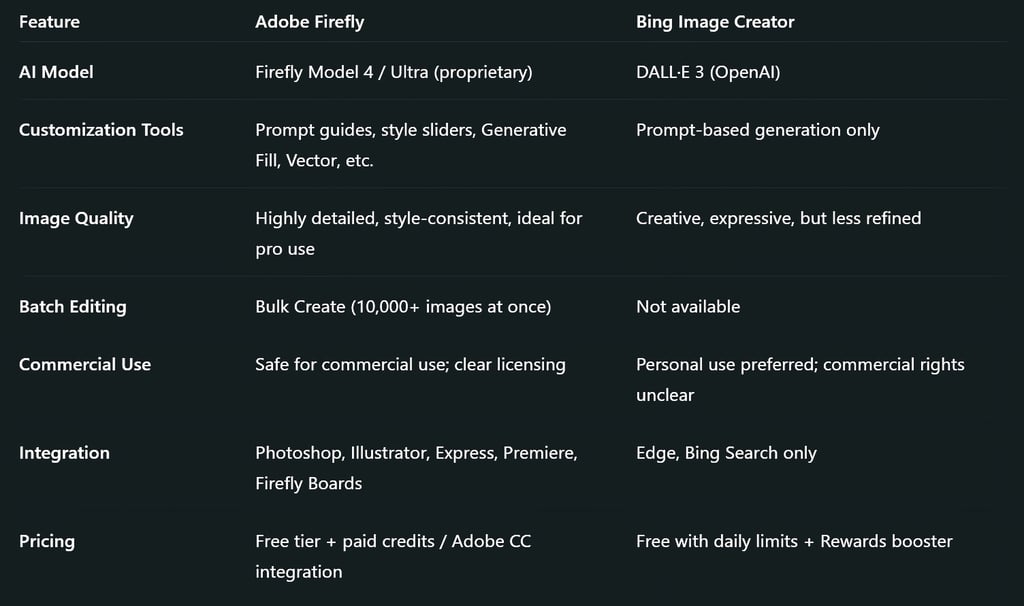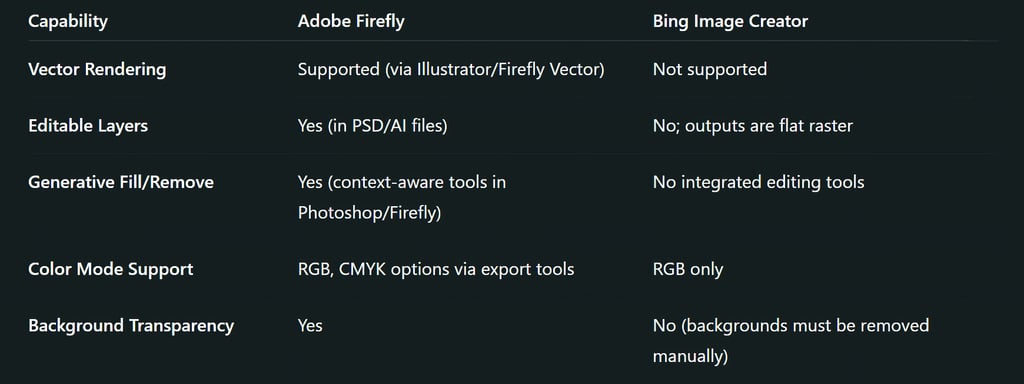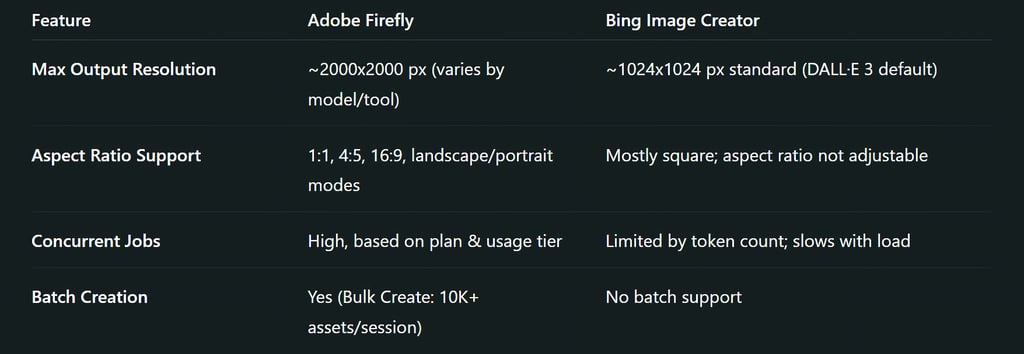
Adobe Firefly vs. Bing Image Creator (2025): Which AI Image Generator Is Right for You?
Compare Adobe Firefly and Bing Image Creator in 2025. Explore features, licensing, quality, and use cases to choose the best AI art tool for your workflow.
EDITOR/TOOLSAI ART TOOLSAI/FUTURE
Sachin K Chaurasiya
8/7/20255 min read


In the fast-evolving world of AI-generated visuals, Adobe Firefly and Bing Image Creator stand out as two of the most popular tools for turning words into stunning images. While they share the same goal—generating images from text prompts—their approach, target audience, features, and pricing differ dramatically.
So, which one is best for your needs in 2025?
Let’s dive deep into a head-to-head comparison between Adobe Firefly and Bing Image Creator, examining everything from output quality to commercial licensing, ease of use, and real-world applications.
What Is Adobe Firefly?
Adobe Firefly is Adobe’s proprietary suite of AI tools built into the Creative Cloud ecosystem. As of 2025, it has evolved significantly with Image Model 4 and Image 4 Ultra, offering hyper-realistic image generation, stylistic consistency, and new features like Firefly Boards for collaborative visual planning and Bulk Create for batch processing.
Firefly stands out because it's built with creators and professionals in mind—providing safe-for-commercial-use outputs, deep integrations with Photoshop and Illustrator, and precision editing tools like Generative Fill and Generative Vector.
What Is Bing Image Creator?
Bing Image Creator, powered by OpenAI’s DALL·E 3, is Microsoft’s answer to casual, fast AI image generation. Accessible directly via Bing.com or Microsoft Edge, it requires no installation or subscription, making it a favorite for students, bloggers, educators, and hobbyists.
You can use it completely free, although there are daily limits on generations. You can unlock faster rendering with Microsoft Rewards points.


Who Is Adobe Firefly Best For?
If you're a:
Graphic designer
Creative agency
Content marketer
Video editor
Social media manager
Brand consultant
...then Adobe Firefly is likely the best fit for you. Its precision tools, commercial licensing, and integration into professional software make it a powerhouse for any creative workflow.
Bonus: Adobe's Firefly Enterprise API and Bulk Create features are perfect for teams handling large-scale visual production.
Who Should Use Bing Image Creator?
Bing Image Creator is ideal for:
Students creating school projects
Bloggers needing quick visuals
Educators creating classroom content
Hobbyists exploring creative ideas
Anyone wanting fast, free AI images
If you're just getting started with AI art, Bing Image Creator is simple, intuitive, and 100% free—no steep learning curve or monthly bills.
Real-World Use Case: Speed vs Control
Let’s say you're designing a campaign for a client in the fashion industry.
With Firefly, you can generate a series of branded concepts, edit them in Photoshop, remove backgrounds, and create social media-ready assets—all with commercial-safe usage.
With Bing Image Creator, you can quickly prototype ideas and generate mood boards, but you’ll lack the advanced editing options and licensing clarity for professional use.

Underlying AI Models
Adobe Firefly
Model Type: Proprietary diffusion-based models (Firefly Image Model 4 and 4 Ultra as of 2025).
Architecture: Custom-trained on Adobe’s proprietary dataset plus public domain and openly licensed content.
Training Focus: Designed for photorealism, stylistic consistency, editable layers, and vector output.
Tokenizer/Parser: Optimized for creative use cases—interprets descriptive, design-language inputs rather than technical shorthand.
Bing Image Creator
Model Type: OpenAI’s DALL·E 3 (cloud-based image generation).
Architecture: Transformer-based diffusion model with prompt optimization layer for natural language understanding.
Training Data: Broad, internet-scale datasets—filtered but more generalized.
Prompt Inference: Optimized for conversational language; uses a reranking system to present best-fit outputs based on user intent.
Platform Integrations & APIs
Adobe Firefly
Creative Cloud Integration: Natively embedded into Photoshop, Illustrator, Adobe Express, and Premiere Pro.
Firefly API: Available for enterprise clients, supporting batch processing, workflow automation, and bulk asset creation.
Data Sync: Generates PSD/AI-friendly outputs with editable layers for non-destructive editing.
File Support: Exports in SVG, PNG, JPEG, and PSD; supports transparent backgrounds, layer masks, and vector paths.
Bing Image Creator
Access Points: Microsoft Bing, Edge Sidebar, Copilot (formerly Cortana), and Windows 11 integration.
No Direct File Layering: All outputs are flat raster images (JPG/PNG) without embedded metadata or editing layers.
Limited API Access: No public API for DALL·E 3 through Bing; Microsoft focuses on web/app integrations.
User Data Sync: Saves image history to Microsoft account (stored for 90 days unless deleted manually).
Data Privacy & Model Transparency
Adobe Firefly
Training Ethics: Fully transparent—only uses licensed/public data; avoids scraping copyrighted materials.
User Prompt Privacy: Prompts are anonymized unless part of shared enterprise projects.
Usage Rights: Users retain full commercial rights to generated content under Adobe’s terms.
Audit Log (Enterprise): Tracks image history and collaboration for regulated industries.
Bing Image Creator
Training Transparency: Limited disclosure; DALL·E trained on OpenAI-curated datasets.
Prompt Logging: Prompts and outputs may be used for model improvement.
Usage Rights: Microsoft does not guarantee commercial safety; users are advised to review content before use.
Content Policy Enforcement: Strong filters on violence, nudity, brand names, and political images—sometimes overzealous.
Performance & Infrastructure
Adobe Firefly
Runs on: Adobe’s AI infrastructure (via AWS and proprietary GPU clusters).
Processing Speed: Prioritizes quality over speed; ~3–6 seconds/generation depending on model.
Supports Enterprise-Grade SLAs: For creative studios and brands needing reliability.
Bing Image Creator
Runs on: Azure + OpenAI infrastructure (shared with Copilot and Edge AI).
Processing Speed: Fast mode: ~1–3 seconds/image; slower when free tokens are exhausted.
Queue Management: Token-based queuing; high demand can delay output.




AI Prompting Guide for Creatives
Mastering Prompts for Adobe Firefly, Bing Image Creator, and Other AI Art Tools
Whether you're designing a product ad, creating concept art, or experimenting with visuals, the secret to stunning AI images lies in how you write your prompt. Here's how to get it right.
Prompt Structure: The 4-Part Framework
Subject—What’s the core element? (e.g., a futuristic samurai)
Style/Medium—What artistic style or medium should it resemble? (watercolor, digital painting, photorealistic)
Details/Descriptors—Add color, mood, perspective, lighting, emotion, or textures.
e.g., glowing armor, sunset background, cinematic lightingModifiers—Add camera settings, lens types, or resolution details if supported.
e.g., 85mm lens, 8K, ultra-detailed, DOF
Technical Tips by Platform
Adobe Firefly
Supports stylization toggles like "Surrealism," "Line Art," "Graphic Novel," and "3D Art"—use these to match brand tone.
Generative Fill and Vector features understand contextual prompts. Example:
fill background with golden leaves in a painterly styleFirefly prefers descriptive, natural-language prompts over comma-separated keywords.
Bing Image Creator (DALL·E 3)
Handles conversational prompts well. Example:
a dreamy illustration of a girl walking through a cyberpunk forest at nightUse narrative-style language:
as if it were part of a Studio Ghibli movie or inspired by a Wes Anderson filmDoesn’t respond to ultra-technical photography terms as well as Firefly, so keep it expressive.
Advanced Prompting Tactics
Prompt Weighting (if supported):
Some platforms allow prioritizing elements using syntax like :: or parentheses.
e.g., futuristic city::2, vintage car::1Negative Prompts (on advanced platforms):
Remove unwanted features. Example:
a serene beach scene—no people, no text, no logosIterative Refinement:
Generate, then re-prompt with tweaks like:
same scene but at night, or add neon lighting and rain
Bonus Tip: AI Prompt Templates
Use and customize this fill-in-the-blank formula:
"[Subject] in [Style], with [Visual Details], captured in [Camera/Render Style]"
Example:
A traditional Japanese temple in ukiyo-e style, surrounded by cherry blossoms, under golden evening light, with soft shadows and intricate linework.
Subscribe To Our Newsletter
All © Copyright reserved by Accessible-Learning Hub
| Terms & Conditions
Knowledge is power. Learn with Us. 📚


